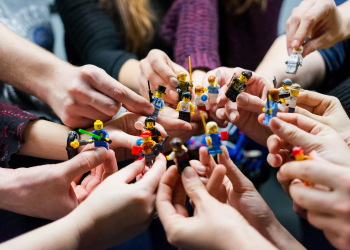Guest blog by Trishna Patnaik – What is quantum physics, and how dos it relates to creativity, innovation, and consciousness?
Quantum physics is a branch of physics also known as quantum mechanics or quantum theory. Mechanics is that part of physics concerned with that matter which moves, from cannonballs to tennis balls, cars, rockets, and planets. Quantum mechanics is that part of physics which describes the motions of objects at molecular, atomic, and sub-atomic levels, such as photons and electrons. Although quantum mechanics is an extraordinarily successful scientific theory, on which much of our modern, tech-obsessed lifestyles depend, it is also completely deranged!
The history of quantum mechanics
We now know that all matter is composed of atoms. Each atom is in turn made up of electrons ‘orbiting’ a nucleus consisting of protons and neutrons. Atoms are discrete. They are ‘localised’: ‘here’ or ‘there’.
Towards the end of the 19th Century, atoms were rather controversial. In fact, it was a determination to refute the existence of atoms that led the German physicist Max Planck to study the properties and behaviour of so-called ‘black-body’ radiation.
What he found in an ‘act of desperation’ in the late-1900 turned him into a committed atomist, but it took a few more years for the real significance of his discovery to sink in. Planck had concluded that radiation is absorbed and emitted as though it is composed of discrete bits which he called quanta.
In 1905, Albert Einstein went further. He speculated that the quanta are real – radiation itself comes in discrete lumps of light-energy. Today we call these lumps photons.
So quantum physics is usually intimidating from the get-go. It’s kind of weird and can seem counter-intuitive, even for the physicists who deal with it every day. But it’s not incomprehensible though!
Quantum Physics Is Not Magic (Indicating Innovation)
Quantum physics is most emphatically not magic. The things it predicts are strange by the standards of everyday physics; they are rigorously constrained by well-understood mathematical rules and principles. So, if somebody comes up to you with a “quantum” idea that seems too good to be true free energy, mystical healing powers, impossible space drives it almost certainly is!
That doesn’t mean we can’t use quantum physics to do amazing things you can find some really appealing physics in mundane technology indicative of innovation but those things stay well within the boundaries of the laws of thermodynamics and just basic common sense.
Quantum Physics and the Mind: The Co-relation (Indicating Creativity)
“I cannot define the real problem, therefore I suspect there’s no real problem, but I’m not sure there’s no real problem.”
The American physicist Richard Feynman said this about the notorious puzzles and paradoxes of quantum mechanics, which is the theory physicists use to describe the tiniest objects in the Universe. He might as well have been talking about the equally knotty problem of consciousness. Some scientists think we already understand what consciousness is, or that it is a mere illusion! Many others feel we have not grasped where consciousness comes from at all.
The perennial puzzle of consciousness has even led some researchers to invoke quantum physics to explain it. That notion has always been met with skepticism, which is not surprising: it does not sound wise to explain one mystery with another. But such ideas are not obviously absurd, and neither are they arbitrary. This is an indication of creativity.
For one thing, the mind seemed, to the great discomfort of physicists, to force its way into early quantum theory. What’s more, quantum computers are predicted to be capable of accomplishing things ordinary computers cannot, which reminds us of how our brains can achieve things that are still beyond artificial intelligence! “Quantum consciousness” is widely derided as mystical woo, but it just will not go away!
Perhaps quantum mechanics is involved in consciousness
After all, the human brain seems able to handle varied cognitive processes that still far exceed the capabilities of digital computers. Perhaps we can even carry out computational tasks that are impossible on ordinary computers, which use classical digital logic.
Every line of thought on the relationship of consciousness to physics runs into deep trouble. It is hard to see how a description of consciousness based purely on pre-quantum physics can account for all the features it seems to have.
One particularly puzzling question is how our conscious minds can experience unique sensations, such as with the colour red or with the smell of frying bacon. With the exception of people with visual impairments, we all know what red is like, but we have no way to communicate the sensation and there is nothing in physics that tells us what it should be like.
Sensations like this are called “qualia”. We perceive them as unified properties of the outside world, but in fact they are products of our consciousness and that is hard to explain. Indeed, in 1995 philosopher David Chalmers dubbed it to be “the hard problem” of consciousness.
The bottom line is, the quantum world just doesn’t work in the way the world around us works. We don’t really have the concepts to deal with it. This problem, it turns out, is not limited to photons. It extends to electrons and protons and other particles as small as or smaller than atoms. Every elementary particle has properties of both a wave and a particle. That idea is called wave-particle duality. It’s one of the biggest mysteries in the study of the smallest parts of the universe. That’s the field known as quantum physics.
Tangled up in particles (indicating Imagination)
Quantum theory includes other fantastic ideas. Like that entanglement. Particles may be entangled or connected even if they’re separated by the width of the universe. This is indicative of imagination.
Imagine, for instance, that you and a friend had two coins with a seemingly magical connection intertwined. If one showed up heads, the other would always be tails. You each take your coins home and then flip them at the same time. If yours comes up heads, then at the exact same moment you know your friend’s coin has just come up to be tails!
Entangled particles work like those coins. In the lab, a physicist can entangle two photons, and then send one of the pair to a lab in a different city. If they measure something about the photon in the lab such as how fast it moves then immediately one knows the same information about the other photon. The two particles behave as though they send signals instantaneously! This will hold even if those particles are now separated by hundreds of kilometers.
As in other parts of quantum theory, that idea causes a big problem. If entangled things send signals to each other instantly, then the message might seem to travel faster than even the speed of light — which, of course, is the speed limit of the universe. So that cannot possibly happen!
Interlink between Consciousness, Quantum Physics (Energy) and Beyond
There is an intricate link between behaviour and biology. Biology has been handed over to us from time immemorial. It’s intertwined with our existence. It’s like a historical, codified legacy that we carry to the next generation. We are the baton of the human race and the planet is the medium. Many of these thoughts may be beyond our control – impulsive behaviours for instance – how does one explain that? We were born free and that seed of thought has been ingrained in our DNAs for eons.
And we, as in life, came from particles – then it’s no small wonder that at an infinitesimal level we are particles or vibrations and that thrives in a medium of its own. Probably our man-made dimensions of the good, bad, and ugly graduate towards the right and the wrong are too few to represent these states. We will need a medium to talk to ourselves at subatomic levels. This is the mind-body connection. A connection that takes us back into the first form of our being! This form of being comes in the very quest to inquire and introspect which is the Quantum Physics (Energy).
About Trishna Patnaik
Trishna has a BSc (in Life Sciences) and MBA (in Marketing) by qualification but an artist by choice. A self-taught artist based in Mumbai, Trishna has been practicing art for over 14 years. After she had a professional stint in various reputed corporates, she realised that she wanted to do something more meaningful. She found her true calling in her passion that is painting. Trishna is now a full-time professional painter pursuing her passion to create and explore to the fullest. She says, “It’s a road less traveled but a journey that I look forward to every day.” Trishna also conducts painting workshops across Mumbai and other metropolitan cities of India. Trishna is an art therapist and healer. She works with clients on a one on one basis in Mumbai. Trishna fancies the art of creative writing and is dappling her hands in that too, to soak in the experience and have an engagement with readers, wanderers, and thinkers.
Find out about The Coach for Innovators Certified Program, a collaborative, intimate, and deep personalized innovation coaching and learning program, supported by a global group of peers over 8-weeks, starting February 2, 2021. It is a blended learning program that will give you a deep understanding of the language, principles, and applications of a human-centred approach to innovation, within your unique context. Find out more.
Contact us now at mailto:janet@imaginenation.com.au to find out how we can partner with you to learn, adapt, and grow your business in the digital age.











